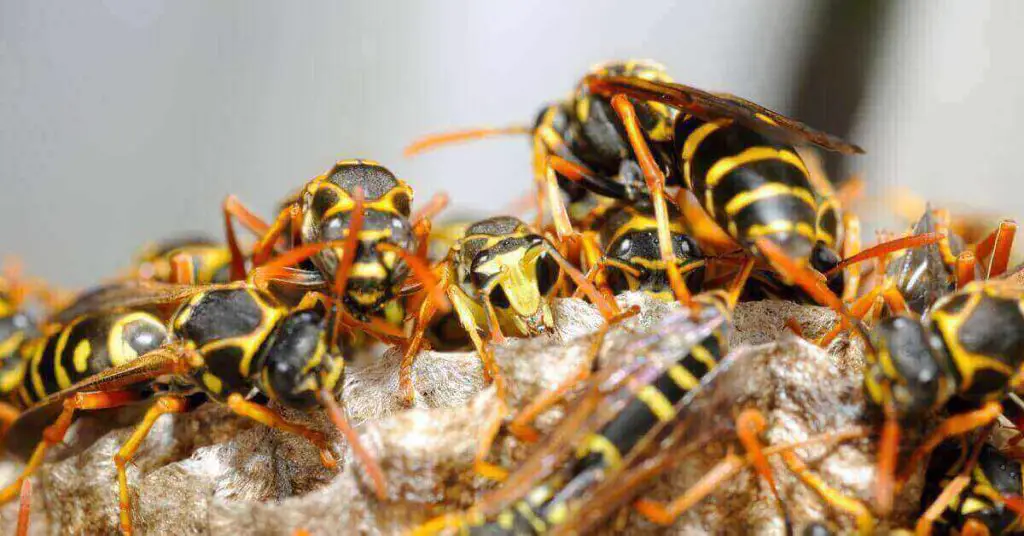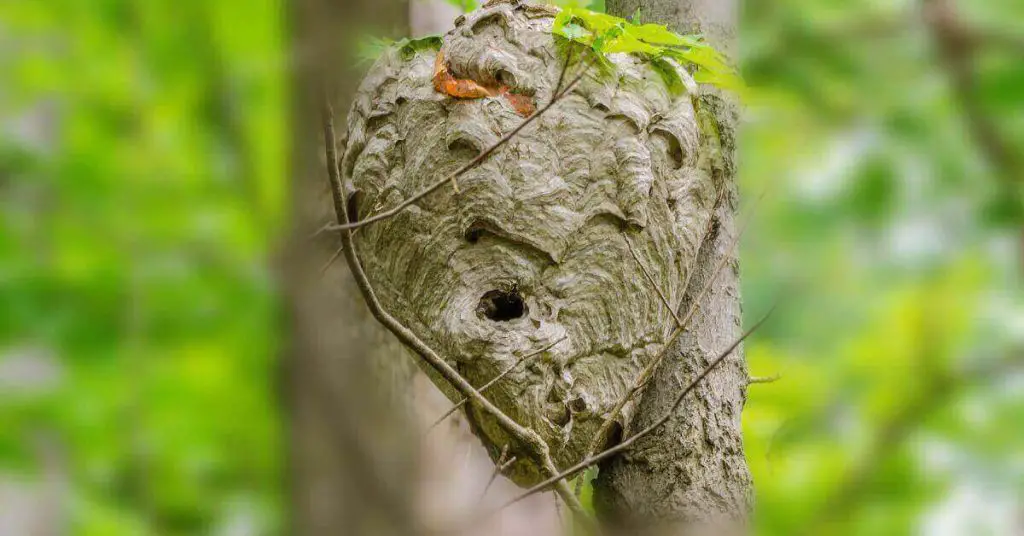Wasps are harmful insects to humans living in gardens, forests, and rocks. Here are many types of wasp nests. Wasps create their nests from different types of wood and tree paper. Wasp nests are different from honey bees. Wasps can chew tree paper and create nests. Clay is a special material that is used in nests. Wasp nests are usually round and have a particular passage made by the wasps for entry and exit. Here in this article, you learn about all types of wasp nests.
Types Wasp Nests
- Paper Wasp Nest
- Yellowjacket Nest
- Mud Dauber Nest
- Baldfaced Hornet Nest
- Cicada Killer Nest
- Potter Wasp Nest
- European Hornet Nest
- Spider Wasp Nest
- Velvet Ant Nest
- Cuckoo Wasp Nest
Mud Dauber Nests

The first types of wasp nests I describe in this article is the mud dauber nest. Because the mud dauber is the nest that most people know about. You can find this nest on trees in your backyard or garden. Wasps use pure mud to build this nest. Wasps live in small families. Mud dauber nests have a different shape. Sometimes wasps build large mud dauber nests and sometimes small dauber nests.
How do the wasps build a mud dauber’s nest?
Wasps have strong jaws used to collect mud. Wasps create a minimum of two nests in a season. At the beginning of spring, wasps build their mud dauber nests in trees and open areas. When the spring season is over, they build their nests in areas covered by roofs.
Wasps Mud Dauber Nest on House
In the summer, most wasps build their mud nest in human homes. Because wasps feel safe in this place, it is dangerous for those living in that house. Female wasps build nests to lay eggs, and 20 to 25 female wasps live in a nest. Removing mud wasp nests from the house is easy if the nest is full. Use only a brush and soap to remove wasp nests. But if the wasps live in this nest. Use a spray to repel wasps from the nest. You need to cover your body, or the bees will attack you.
Cicada Killer Wasps Nest

Wasps create this type of nest in the ground. Because those wasps in this nest are solitary and much more aggressive. Cicada killer wasps are brown and are also called ground hornets. These wasps live in large groups, so they need a large nest to live..
Wasps build cicada nests in the ground because There is plenty of space for laying eggs. His nest looks like an ant’s nest. We cannot measure the exact length of the cicada killer nest.
Wasps Nests

Paper wasps are black with yellow lines on the body. These wasp and European wasps look the same, but their size is different. Paper wasps’ antennae are larger than other wasps. These wasps are found in urban areas. Australian paper wasps are much more famous then these wasps.
Nesting Habits
Paper wasp build best types of wasp nests. Paper wasps build their nest by chewing wood using their saliva. Wasps collect soft wood covers, chew them in their mouths, and build their nest. Every wasp performs his duty to build nests. Paper wasp nests are covered with three layers that protect the wasp eggs from rain. All the wasps have a duty to build their nests. During the winter, wasps build their nests under the tree’s bark. Usually, queen bees do this job because it is the only wasp that can survive in winter.
Types of wasp nests in trees
Wasp nests found in trees are fascinating structures created by these industrious insects. They select tree branches, hollows, or crevices as their nesting sites, showcasing their adaptability to various environments.
The construction of a wasp nest typically starts with the queen wasp selecting a suitable location within a tree. She then collects wood fibers by scraping or chewing on nearby surfaces, mixing them with saliva to create a papery pulp. Using this pulp, the queen constructs the initial cells of the nest, attaching them to the chosen spot on the tree.

As the colony grows, worker wasps take over the nest-building duties. They continue to gather wood fibers, adding more layers to the nest. This results in a characteristic layered or comb-like structure that offers protection to the developing wasp larvae.
The tree provides both advantages and challenges for the wasps. Being elevated off the ground offers protection from ground-dwelling predators, and the tree’s height provides a vantage point for spotting potential food sources. Additionally, the structure of the tree branches offers natural support for the nest.
Methods For Paper Wasp Nest Removal
If you need to remove paper wasps nests, follow these steps.
| 1 | Use spray directly to remove wasps. |
| 2 | Use pyrid spray because it is the best spray to remove all kinds of pests. You can use this spray to get rid of all kinds of pests. Pyrid is the most effective. |
| 3 | Stand at least two or three feet away from wasps when treated from spyraid. |
| 4 | Spray directly into the wasps’ nest. |
| 5 | Pyrid removes pests part-time. |
| 6 | Another chemical is Sylo, which protects your home from wasps and other pests for up to 90 days. |
| 7 | When the sprinkling process is complete, get a long stick and drop the nest on the ground. |
| 8 | Do not try to kill wasps. |
Potter Wasp Nest
Potter wasps are different from all other bees because of their body. These wasps’ bodies are long, and the central area of their body is long and slim. Potter bees are black and yellow and are mostly found in California. Potter wasps create their nest by using mud and clay. Mud dauber wasp nests are the same as potter nests, both use mud and clay, but the nest’s shapes and sizes differ. Potter wasp nests are smaller in size than mud dauber nests. These wasps build single nests in the same place; every wasp has its own nest. The Queen Potter wasps lay only one egg in the nest.
Spider Wasp Nest
Spider wasps create burrows in the ground to lay their eggs. They often choose areas with loose soil, where they can construct individual chambers for each egg.
Velvet Ant Nest
Velvet ants (which are actually a type of wasp) do not build traditional nests. They are solitary wasps, and each female digs a burrow in the ground to lay her eggs.
Cuckoo Wasp Nest
Cuckoo wasps are parasitic wasps that do not build nests. Instead, they lay their eggs in the nests of other solitary wasps.
How Do Potter Wasps Build Nests?
These wasps use their legs to build nests. Potter collects mud on his legs. Female nests differ from female bees that make their nest in the ground. If you want to see a potter’s nest, it is easy to find it in your house’s walls and empty spaces where no one lives. Potter wasps are stingy. These wasps have strong and painful stingers but are not very dangerous. If you are stung by potter wasps, apply water or ice to the affected area to prevent an allergic reaction.
Related Articles:
- Types of Bee Nests in Ground & Trees.
- Different Types of Beehives and Beehive Benefits.
- Ants In Beehives. How to Protect Bees From Ants?
Bald-Faced Hornet Nest

Bald-faced hornets are brown and black. These wasps nest only in trees. These wasps are not related to ground wasps. Like other wasps, these wasps collect fibers for building nests. This species of wasps make their home only on trees. Paper wasp and bald-faced wasp nests are similar. Both wasps build their nests in the same way.
Bald-faced wasps’ nests are larger than paper wasps. The size of the nests is 20 to 25 inches large. In winter, the queen does not die, but the nets are destroyed. Their nests are brown and gray. These wasps are aggressive and sting multiple times without any problem.
Types of Wasp Nests Florida
In florida Location, wasps have different types of nests according to species. Yellow jacket wasps create nest in tree, ground and other places. All other wasps create there nests in under bushes, trees, ground and home roof tops.
Bald Faced Hornet Nest Removal Methods
| 1 | First, cover your face and hands |
| 2 | Close the nest opening hole first. |
| 3 | Do this at night. |
| 4 | If the nest is high, use something to hold the nest after removal. |
| 5 | Could you not open it at home or in public? |
| 6 | After removing, use the spray to remove wasps. |
| 7 | When the wasps are removed, sell the nest. |
World Large Wasps Nest
In 1963, New Zealand’s largest wasp nests were found, about 12 feet long and 5 ft wide. It is the world record for the world’s largest wasp nest.
Conclusion
Like bees, wasps have many types and live in all countries of the world. Waps are different from bees in shape and habits. Some wasps are dangerous because of his sting. Their sting is more powerful than bees. Wasps sting many times. Australian wasps are dangerous. If you read this article i make sure you will learn all about wasps and all types of wasp nests.
